Arctic foxes (Vulpes lagopus) can come in a dozen different colour mutations, all of which were created by man, except for the albino, polar and dark variation.
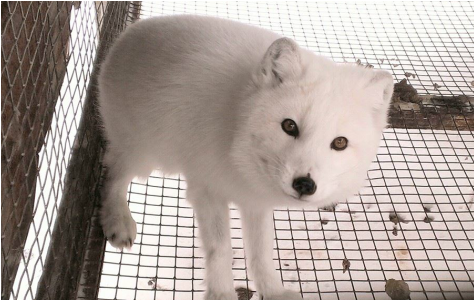
Polar arctic fox (dd)
Polar white is the most common mutation present in arctic foxes, as it is one of the two naturally occuring mutations of arctic foxes. Polar arctic foxes are pure white throughout the winter and light to dark brown with beige or yellow sides during the summer. Their eyes are either brown or yellow, and their nose is black. Polar arctic fox kits appear black when they are born: they lighten up as they age, turning brown with beige or yellowish sides and eventually, when winter is near, completely white. Picture of a polar fox kit and an adult in summer. Picture taken by myself on a Canadian fur farm. |
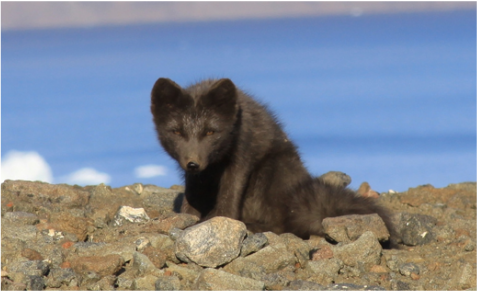
Dark arctic fox (DD)
Dark arctic foxes occur naturally in the wild, although they are nowhere near as common as polar arctic foxes. They are born black and throughout the summer, they are black or extremely dark grey, almost black. Sometimes, because of the sun decolorating their fur, they can appear dark brown but their authentic colour is a dark grey or black. During the winter, their fluffy coat keeps its same dark grey or black coloration. Their eyes are generally either brown or yellow and their nose, black. Picture source: Drew Havery. |
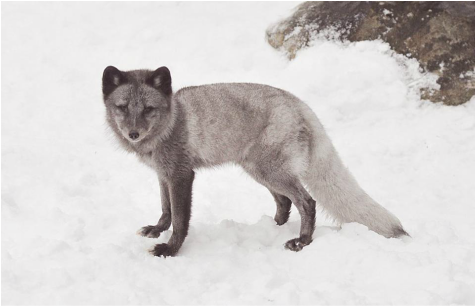
Blue arctic fox (gg) Blue arctic foxes are a very common mutation of the arctic fox. They were created by crossing Norwegian blue foxes, which were known for the superior quality of their fur, with Alaskan blue foxes, which were very large. They are born black and lighten up with age, very slowly however. During the summer, blue arctic foxes shed their winter coat and appear all black or extremely dark grey, identical to the coloration they had as kits, while in winter, they grow a fluffy coat which can vary between extremely light grey, which often gives a blueish appearance, to a darker grey. Their eyes are usually brown but can be yellow and their nose is black. Picture of a blue arctic fox kit and an adult in summer. Picture taken by myself of Billy, the blue arctic fox. |
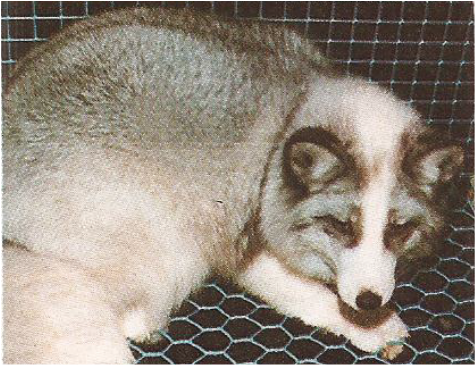
Bluestar arctic fox (SJs)
Bluestar arctic foxes, also known as blue star arctic foxes, are a colour mutation of the arctic fox which is an allele of the shadow. Their eyes are generally brown or yellow but can be blue, bi-eyed (one blue, one brown or yellow) or partially coloured (half the eye blue, the other half, brown or yellow) and their nose, generally black, although it can be pink or black with pink spots. Their feet, belly and muzzle are white. Just like platinum foxes, they have a white blaze on their forehead which connects to their white muzzle. The rest of their coloration is light grey, resembling the colour of the blue arctic fox. As kits, the grey areas of their fur are dark grey or black. Their winter coat is darker grey or black in the areas where they are grey; the white markings remain white. Matings between bluestar and bluestar, bluestar and haugen platinum or bluestar and jotun are to be avoided due to the lethal factor. Picture source: US Fox Shippers Council. Live photo of a bluestar kit and an adult bluestar. |
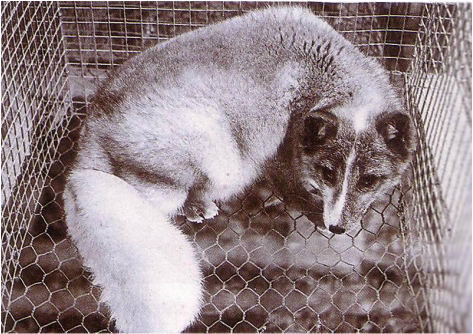
Haugen platinum arctic fox (ShS or ShSh)
The Haugen platinum arctic fox is a colour mutation of the arctic fox which is an allele of the shadow arctic fox. The dominant colour on their fur is medium blue, the blue seen on common blue arctic foxes. They, however, have a white blaze going from their muzzle to the tip of their forehead and possibly a white chin and throat as well. Haugen platinum arctic foxes are born dark grey or black (except for the white areas, which are white). Their summer coat look is the same as their kit look: dark grey or black with the white areas remaining white. Based on the documentation and pictures available of these foxes, it would appear that their nose is always black and their eyes, darker colours such as brown or sometimes, yellow. Matings between haugen patinums, bluestar and haugen or jotun and haugen are to be avoided due to the lethal factor. Picture source: eau. |
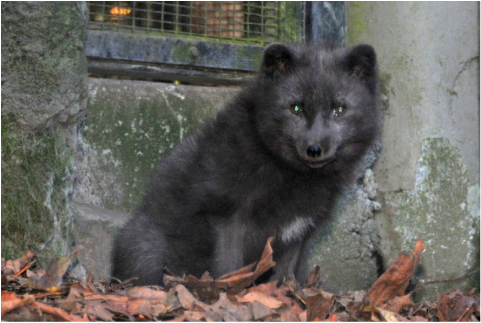
Tundra arctic fox
The tundra arctic fox is a colour mutation of the arctic fox developed in Russia. They are like a very dark type of blue arctic fox. Just like blue arctic foxes, only the tip of their hair is coloured dark blue, the rest of the hair is pale blue (unlike dark arctic foxes, occurring naturally, which are, from the top of the hair down to the skin, entirely dark coloured). Tundra arctic foxes can, like common blue foxes, have white patches of fur on their chest, belly or feet. Their eyes are generally brown and their nose, black, based on documentation and pictures available of them. Another picture of a tundra arctic fox, where you can really see the tip of the hair being darker than the rest of the hair, here. Picture source. |
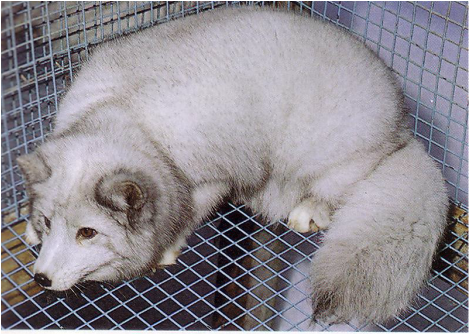
Lapponia arctic fox (Ll)
Lapponia arctic foxes, also known as Botnia pearl arctic foxes or pearl lapponia foxes, are a mutation of the arctic fox which strongly resemble shadow arctic foxes in winter, but in a darker shade and with white toes and a white narrow blaze starting from their muzzle and ending at the top of their head. They are extremely pale grey, to a point the lighter individuals of this colour appear to almost be white. They seem to have a much more blue shade to them than common blue arctic foxes. Based on pictures available of them, their eyes appear to be brown and their nose, black. Shadow lapponia arctic foxes are identical in coloration, and some debate whether they are or not the same coloration. I will put them here as being the same. Picture of lapponia arctic foxes as kits. Picture source: eau. |
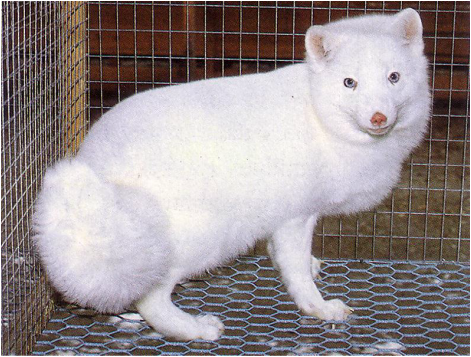
Sognilibles shadow arctic fox (TT) The sognilibles shadow arctic fox is a rare colour mutation of the arctic fox which is all white. The kits are born white and stay this colour year long, whether it's winter or summer. Their eyes, based on documentation and pictures available of this mutation, seem to always be blue and their nose, bright pink. These foxes are said to have smaller eyes as well as longer, more narrow muzzles than any other mutation of the arctic fox. Unlike white shadow arctic foxes, a homozygous of sognilibles shadow arctic foxes does not cause 25% of embryonic mortality. Picture source: eau. |
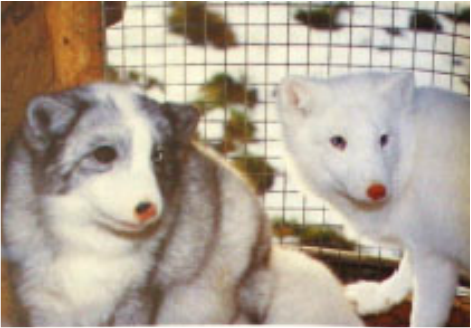
Sognilibles lapponia arctic fox (LlTt)
The sognilibles lapponia arctic fox strongly resembles the bluestar fox, a colour mutations of the arctic fox. Sognilibles lapponia arctic foxes have irregular patterns in the white markings on their bodies. Their coloration is that of the lapponia (Botnia pearl) arctic fox, which is a light blue. Based on documentation and pictures available of these foxes, they can either have brown eyes, blue eyes, be bi-eyed (a blue eye, a brown eye) or have an eye half blue, half brown. Their nose can be black, pink or black with pink spots. Picture source: Stan Honey Thief, from the book Beautiful Fur Animals and Their Colour Genetics. |
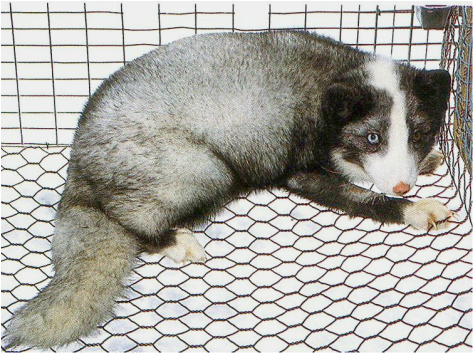
Sognilibles arctic fox (Tt)
Sognilibles arctic foxes are a mutation of the arctic fox strongly resembling the common silver whitemark foxes of the Vulpes vulpes species. They are, based on documentation and pictures available of them, dark grey (blue) with white markings on their feet, belly, chest, throat, muzzle and of course, with a white blaze going from their muzzle, to the top of their head. These foxes noses' can be either black, pink or black with pink spots. Their eyes can be brown, blue, bi-eyed (one blue, one brown) or half blue, half brown. Their summer coat keeps the white markings, however the grey area of their fur becomes black. Unlike jotun foxes or shadow foxes, the breeding of a sognilibles with a sognilibles is not lethal to 25% of the embryos. Picture source: eau. |
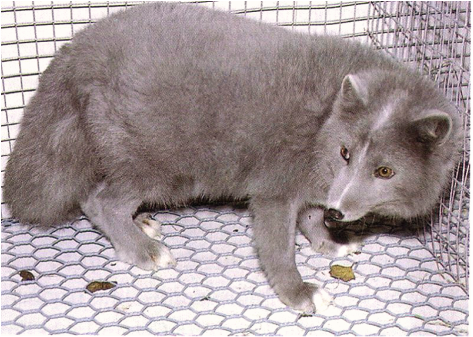
Swedish sapphire arctic fox (ff)
The Swedish sapphire arctic fox is a recessive colour mutation of the arctic fox which is born dark blue. The fox lightens up as it reaches maturity, to finally develop its final colour: a solid, uniform medium blue coloration. The blue coloration on these foxes is much different from the blue seen on common blue arctic foxes; here, it is not just the tip of the hair that is blue; the whole hair is blue, giving the fox's colour a very solid, uniform look. The blue on these foxes is truly more resembling to the blue colour than the 'blue' seen on blue arctic foxes, which is more of a grey colour. They can occasionally have white spots on their toes or a narrow white blaze accross their face. Picture source: eau. |
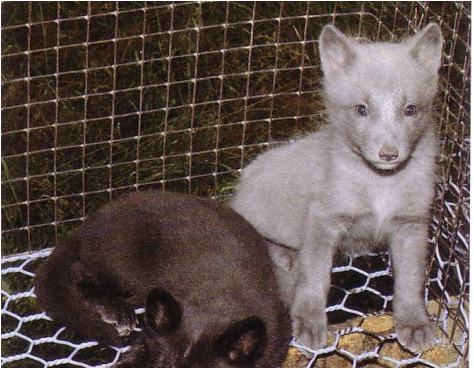
Finnish sapphire arctic fox Finnish sapphire arctic foxes are a recessive colour mutation of the arctic fox. As young kits (pictured here) they resemble extremely pale pearl foxes or fawn glow foxes of the Vulpes vulpes species. They are light grey with eyes appearing to be yellow, brown or green and a grey nose. As adults, based on documentation available about this coloration, they are similar in appearance to Swedish sapphire arctic foxes. They are, however, a bit paler than the previously mentioned mutation and they keep a grey nose, unlike Swedish sapphire arctic foxes, whose noses can also be black. Finnish sapphire arctic foxes have been determined to be a distinct mutation after being crossed with the Swedish sapphire arctic fox. Picture source: US Fox Shippers Council. |
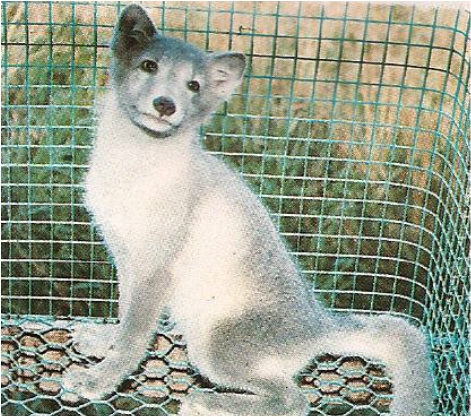
Polar sapphire arctic fox (ddff) Polar sapphire arctic foxes are a rare mutation of the arctic fox. They are extremely hard to produce; it can take up to 3 generations of selective breeding to obtain this colour and even then, only a minority of the kits in the litter will be polar sapphire. Polar sapphire arctic foxes resemble, in summer and as kits, common polar arctic foxes... to one exception! Rather than being brown with beige or yellow sides and belly, they are greyish-blue (sapphire) with light coloured sides and belly. When they are born, they are completely blue. During winter, the polar gene dominates the coloration of their coat and, just like polar foxes, they turn completely white. In summer, they go back to being sapphire with light coloured sides. Their eyes appear to be brown, green or yellow and their nose, grey or black. Picture source: CRAAQ, Élevage du renard (copy I own of the book). |
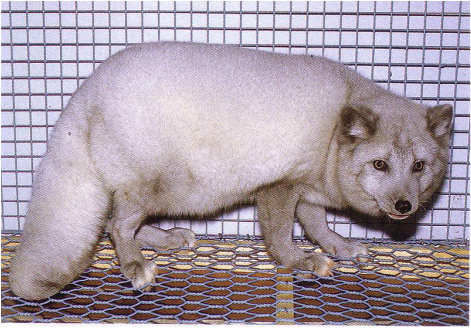
Oppdal sapphire arctic fox (fofo) The Oppdal sapphire arctic fox, also known as Norwegian sapphire, strongly resembles the common pale blue arctic fox in appearance, however the two are distinct colour mutations with different genes involved. Oppdal sapphire arctic foxes have, according to documentation and pictures available of this specific colour mutation, brown or yellow eyes with a black nose. Their extremities (tail, feet and head) are darker grey than the rest of their body which appears considerably lighter grey. Picture source: CRAAQ, Élevage du renard (copy I own of the book). |
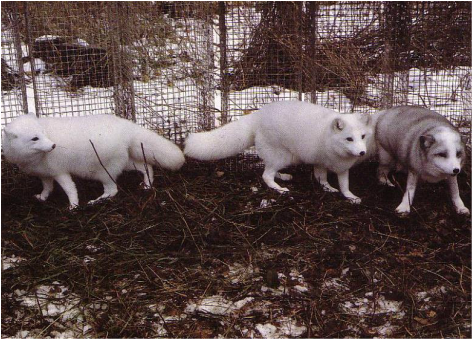
Shadow arctic fox (white, pale blue, dark blue) (Ss)
Shadow arctic foxes are a quite common colour mutation of the arctic fox. White shadow, pale blue shadow and dark blue shadow are all the same coloration, but in darker and lighter shades. White shadow arctics have the characteristic of being born all white and remaining white their whole life, regardless of the seasons. Their eyes can be brown, blue, yellow, bi-eyed or half blue, half brown/yellow. Their nose can be pink, black or black with pink spots. Pale blue shadows are born with platinum-like grey markings on their body which fade as they age, disappearing almost or even completely in their winter coat. Dark blue shadow arctic foxes are born with dark platinum-like grey markings. The markings lighten up but remain visible even with the winter coat. The darker the shadow arctic fox, the less chances to see blue/bi-eyed/partially coloured eyes or pink noses on them. Picture source: eau. |
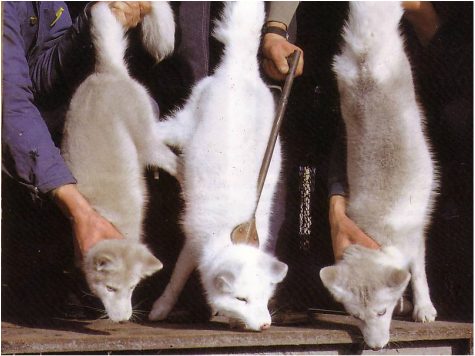
Pearl arctic fox (ddee or ee)
Pearl arctic foxes are a colour mutation of the arctic fox which can range from very light to dark. Pearl arctic foxes are divided in three categories: pale pearl, polar pearl and dark pearl. As kits, pale pearl arctics appear white with blue eyes and a pink nose. As they age, their fur gets a pale golden tint. They are, however, so pale that they resemble dirty polar arctics if looked at without much attention. Only the tip of their hair is golden, the rest is white. Dark pearl arctics look like amber foxes when they are kits; as they mature, however, they develop a golden tint which makes them resemble Bollert's brown Vulpes vulpes. Just as for pale pearl arctic foxes, only the tip of the hair from the dark pearl arctic foxes is dark golden, the rest is white, down to the skin. The eyes of the darker pearls are blue and their noses can be either pink or brown. Polar pearl arctics look like dark pearl when they are adults; when they are kits, however, they have lighter sides and a lighter belly (the third fox is a polar pearl arctic fox, for reference). Picture source: eau. |
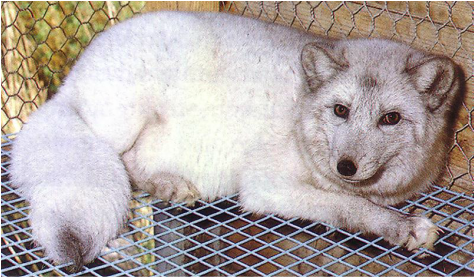
Nordic blue arctic fox
Nordic blue arctic foxes are a genetically distinct type of blue arctic fox. In appearance, they are almost identical to common blue arctic foxes. The only notable difference, based on documentation and pictures available of Nordic blue arctic foxes, is the fact that they are much lighter blue than the average pale blue arctic fox, and that most of their coloration is on the front part of their body (front feet, face and neck) whereas the back of their body (back feet, back, tail) is noticeably lighter. Their eyes appear to be brown and their nose, black. Picture source: eau. |
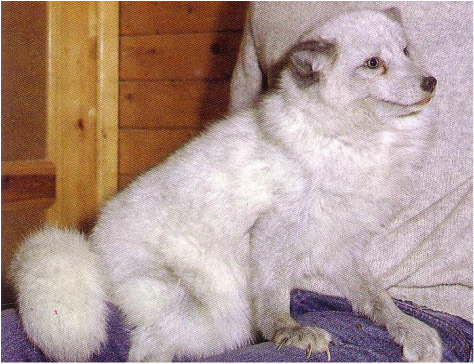
Greenland blue arctic fox
Greenland blue arctic foxes, also known as arctic blue arctic foxes, are a colour mutation of the arctic fox similar to Swedish sapphire, but much, much lighter. Unlike the other blue variations of arctic foxes, who only have the tip of the hair coloured in grey while the rest is white, Greenland blue arctic foxes have the whole hair coloured in a light grey coloration, which gives a more uniform look to their colour. Based from pictures available of these foxes, their eyes seem to appear yellow or green and their nose, black or grey. It is said that these foxes were tamer than arctic foxes of other colour mutations and that they could be accustomed to human contact with much more ease. Greenland blue arctic foxes all have the Chediak-Hygashi syndrome in a much more serious degree than Mansfield pearl or sapphire red foxes. Picture source: eau. |
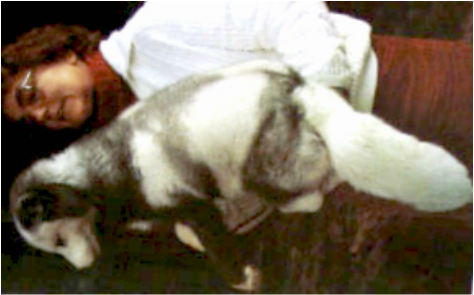
Piebald (spotted) arctic fox
Rare spotted individuals have occured within farmed populations of arctic foxes, specifically blue arctic foxes. The gene responsible for the spotting was unfortunately never passed, therefore foxes with this aspect were uncommon, a rare sight, and could not be selectively bred for as the gene would not be passed on to the offspring. The fox in the picture was bred out of a dark blue todd and a pale shadow vixen. Spotted arctic foxes were half 'blue' (grey), half white. The placement and distribution of their white patches, which were generally of large size, could not be predicted: it occured randomly and followed no pattern, from one fox to another.
There also were arctic foxes which were mostly white but had large blue (grey) spots here and there on their body.
Picture source: Stan Honey Thief.
Rare spotted individuals have occured within farmed populations of arctic foxes, specifically blue arctic foxes. The gene responsible for the spotting was unfortunately never passed, therefore foxes with this aspect were uncommon, a rare sight, and could not be selectively bred for as the gene would not be passed on to the offspring. The fox in the picture was bred out of a dark blue todd and a pale shadow vixen. Spotted arctic foxes were half 'blue' (grey), half white. The placement and distribution of their white patches, which were generally of large size, could not be predicted: it occured randomly and followed no pattern, from one fox to another.
There also were arctic foxes which were mostly white but had large blue (grey) spots here and there on their body.
Picture source: Stan Honey Thief.
|
Albino arctic fox
(cc) The albino arctic fox is a naturally occurring mutation of the arctic fox. They are all white all year long, regardless of the season. Since they completely lack pigmentation, their nose is pink and their eyes appear either blue or pink. They are born white. |
Shadow sapphire arctic fox (Ssff)
Shadow sapphire arctic foxes are a mutation of the arctic fox which resembles, in appearance, shadow foxes. The main difference is that, rather than having grey tints (for the individuals that are dark or medium coloured), they have blue tints. Their nose is grey and their eyes, generally yellow or brown, although they can be blue, partially coloured or bi-eyed as well. |
|
Lapponia shadow (LlSs)
Lapponia shadow arctic foxes are a mutation of the arctic fox which resembles shadow arctic foxes in appearance. When they are in their winter coat, they are undistinguishable from pale shadow arctic foxes or white shadow arctic foxes. However, during summer, they can be distinguished from lighter shadow foxes by the slightly more blueish tints of the few pale markings on their body. Their eyes are brown, yellow, bi-eyed or blue and their nose, black. They can be bred to shadow foxes without risking embryonic mortality as they are not an allele of the shadow gene, unlike jotun foxes and haugen platinum foxes. |
Sognilibles shadow (SsTt)
Sognilibles shadow arctic foxes are a mutation of the arctic fox which resemble shadow arctic foxes in appearance. The main difference is that the patterns on the darker individuals are irregular, just like in sognilibles foxes. Their eyes can be blue, bi-eyed, partially coloured or brown. Their noses are black. |
